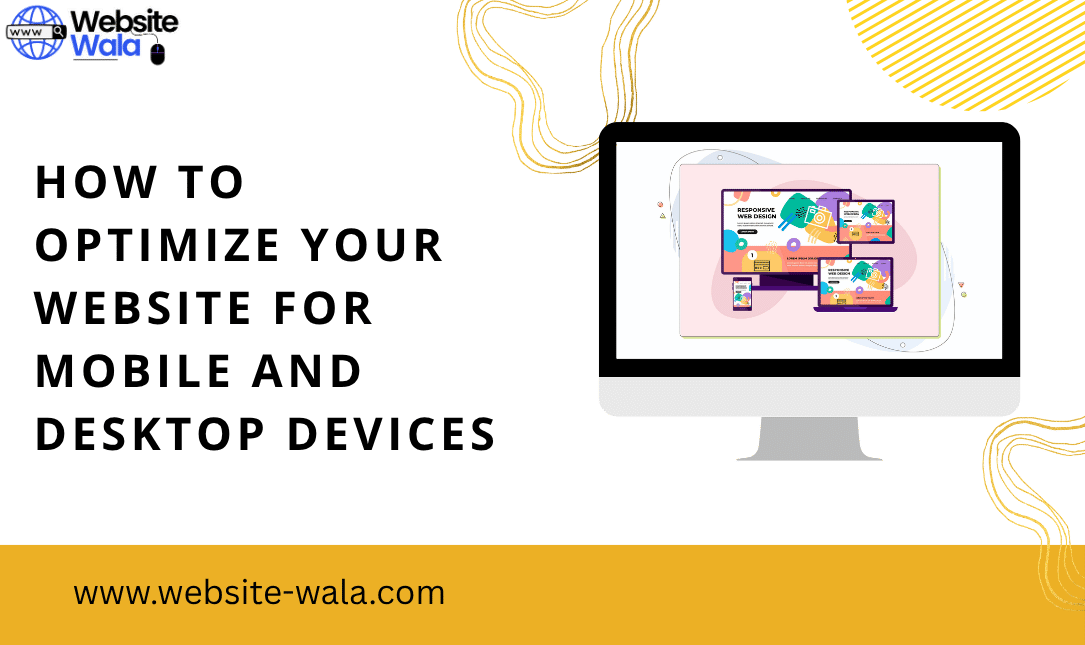
Learn How to Optimize Your Website for Mobile and Desktop Devices to boost website performance, user experience, and SEO across all platforms.
In today’s digital era, having a website that performs seamlessly on both mobile and desktop devices is no longer optional—it’s essential. Understanding how to optimize your website for mobile and desktop devices can significantly enhance user engagement, website traffic, and overall website visibility. This guide will provide actionable steps and strategies to ensure your site delivers exceptional user experience across all platforms.
Why Website Optimization Matters
Website optimization is the process of improving your website’s functionality, speed, and design to provide an optimal experience for users. With the majority of web traffic now coming from mobile devices, mastering mobile optimization is crucial. At the same time, ensuring excellent desktop optimization is equally important for users who prefer larger screens. A well-optimized website contributes to higher website performance, better SEO, and improved website traffic.
Understanding Responsive Design
One of the fundamental concepts in optimizing your site is responsive design. A responsive website automatically adjusts its layout and content based on the device being used, whether it’s a smartphone, tablet, or desktop computer. Implementing responsive design ensures cross-device compatibility, meaning your site looks and functions perfectly across all devices. This approach not only enhances user experience but also supports search engine optimization, as search engines favor mobile-friendly and responsive websites.
Mobile-First Design: A Strategic Approach
A mobile-first design strategy prioritizes the mobile version of your website during the design process. Since mobile users now outnumber desktop users in many industries, focusing on mobile-friendly design ensures that your site is easily navigable, loads quickly, and provides a seamless experience. Key considerations for mobile optimization include:
-
Simplified Navigation: Ensure menus and buttons are touch-friendly.
-
Fast Website Speed: Optimize images, leverage browser caching, and minimize unnecessary scripts.
-
Readable Content: Use legible fonts and proper spacing to enhance readability.
-
Mobile SEO: Optimize meta tags, headings, and content specifically for mobile search queries.
By implementing mobile-first design, you inherently improve website responsiveness, which also benefits desktop SEO and overall website performance.
Desktop Optimization Techniques
While mobile optimization is critical, desktop optimization remains essential for users who prefer a full-screen experience. Some key strategies include:
-
High-Resolution Images: Use images optimized for large screens without slowing down website speed.
-
Interactive Features: Incorporate dynamic content like videos, sliders, and interactive maps for an engaging experience.
-
Clear Layouts: Use ample whitespace and intuitive navigation to improve user experience.
-
Desktop SEO: Optimize content structure, headings, and internal linking to enhance website visibility on desktop searches.
Ensuring both mobile and desktop versions are optimized guarantees consistent performance across all devices, improving cross-device compatibility and fostering trust among users.
Improving Website Speed and Performance
Website speed is a critical factor in website optimization. Slow-loading websites can negatively impact user experience, increase bounce rates, and reduce website traffic. To boost website performance, consider the following:
-
Optimize Images: Compress images without sacrificing quality.
-
Minimize HTTP Requests: Reduce the number of elements on each page.
-
Enable Browser Caching: Allow frequently accessed resources to load faster.
-
Use Content Delivery Networks (CDNs): Distribute content globally to reduce load times.
-
Mobile SEO Optimization: Fast-loading pages improve rankings for mobile search results.
A focus on website speed benefits both mobile and desktop users, making your site more competitive in search engine optimization.
Enhancing User Experience Across Devices
A great website is defined by the quality of its user experience. To enhance UX for both mobile and desktop users, pay attention to:
-
Intuitive Navigation: Ensure menus are easy to use on both touchscreens and desktops.
-
Consistent Branding: Maintain consistent visuals and messaging across devices.
-
Accessibility: Include features like alt text for images and keyboard-friendly navigation.
-
Engaging Content: Use multimedia elements strategically to keep users engaged without slowing down the site.
By prioritizing user experience, you indirectly improve website traffic and website visibility, as happy users are more likely to stay longer and return.
Leveraging SEO for Cross-Device Optimization
Search engine optimization (SEO) plays a vital role in increasing website visibility. Both mobile SEO and desktop SEO are essential components of website optimization. Key tactics include:
-
Keyword Optimization: Use relevant keywords naturally in headings, content, and meta tags.
-
Structured Data: Help search engines understand your content better with schema markup.
-
Internal Linking: Facilitate easy navigation and distribute page authority effectively.
-
Technical SEO: Ensure proper indexing, XML sitemaps, and secure HTTPS protocols.
By implementing these strategies, you enhance website responsiveness and ensure your site performs well across all devices.
Tools for Website Optimization
Several website tools can simplify the process of optimizing your site for mobile and desktop devices:
-
Google PageSpeed Insights: Measures page load times and suggests improvements.
-
GTmetrix: Offers detailed analysis of website speed and performance.
-
Screaming Frog SEO Spider: Analyzes SEO and detects technical issues.
-
BrowserStack: Tests cross-device compatibility across multiple devices and browsers.
-
Mobile-Friendly Test by Google: Evaluates your mobile optimization efforts.
These website tools can provide actionable insights to enhance both mobile and desktop optimization efficiently.
Monitoring and Continuous Improvement
Website optimization is not a one-time task—it requires continuous monitoring and adjustment. Track metrics such as website speed, bounce rates, user experience, and website traffic to identify areas for improvement. Regular updates and testing ensure your site remains optimized for both mobile and desktop devices, maintaining strong website visibility and competitive SEO performance.
Conclusion
Understanding how to optimize your website for mobile and desktop devices is essential for any business aiming to enhance its online presence. By implementing mobile-first design, ensuring responsive design, focusing on website speed, and leveraging SEO strategies, you can deliver an exceptional user experience across all devices. Utilize website tools to monitor performance and maintain cross-device compatibility, ultimately boosting website traffic and improving website visibility. A fully optimized website is the cornerstone of effective digital marketing, driving engagement and growth in today’s competitive online landscape.























